CVD Prevention: Health Promotion for Indigenous Australian Men
VerifiedAdded on 2023/06/07
|10
|2741
|441
Report
AI Summary
This report outlines a health promotion project focused on preventing cardiovascular disease (CVD) among Indigenous Australian males, who experience a disproportionately high morbidity rate from this condition. The project targets men over 70, identified as the group with the highest CVD prevalence. It emphasizes the importance of health promotion in improving quality of life through public awareness and education, aiming to reduce modifiable risk factors such as smoking, poor diet, and physical inactivity. The project employs a primary prevention approach, focusing on creating supportive healthy environments and promoting health education. Key strategies include stakeholder consultation, community mobilization, policy implementation, and media campaigns. The project's success will be evaluated through formative, process, and summative evaluations to ensure that the set objectives and goals are met efficiently and effectively. Desklib offers a variety of resources including past papers and solved assignments for students.
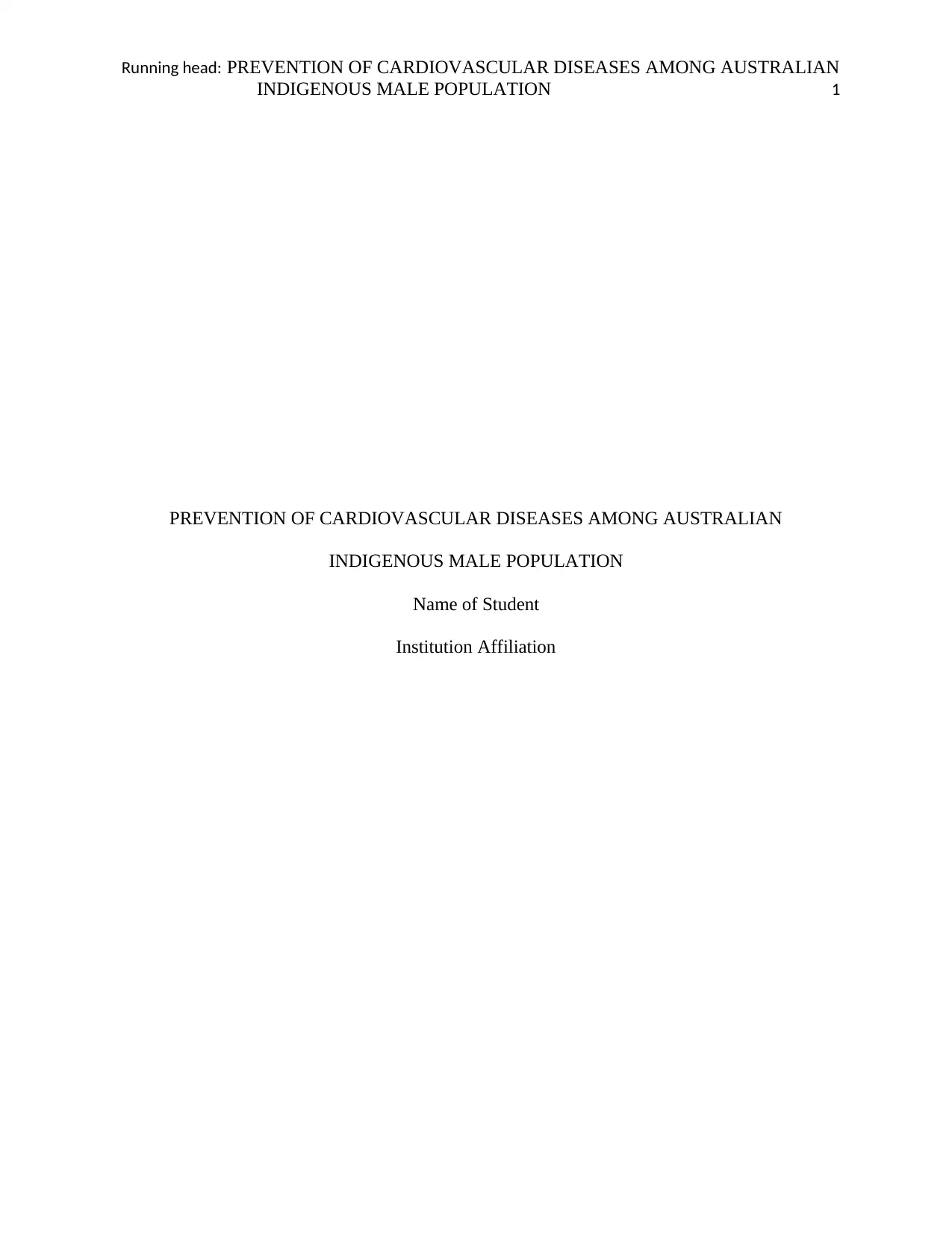
Running head: PREVENTION OF CARDIOVASCULAR DISEASES AMONG AUSTRALIAN
INDIGENOUS MALE POPULATION 1
PREVENTION OF CARDIOVASCULAR DISEASES AMONG AUSTRALIAN
INDIGENOUS MALE POPULATION
Name of Student
Institution Affiliation
INDIGENOUS MALE POPULATION 1
PREVENTION OF CARDIOVASCULAR DISEASES AMONG AUSTRALIAN
INDIGENOUS MALE POPULATION
Name of Student
Institution Affiliation
Paraphrase This Document
Need a fresh take? Get an instant paraphrase of this document with our AI Paraphraser
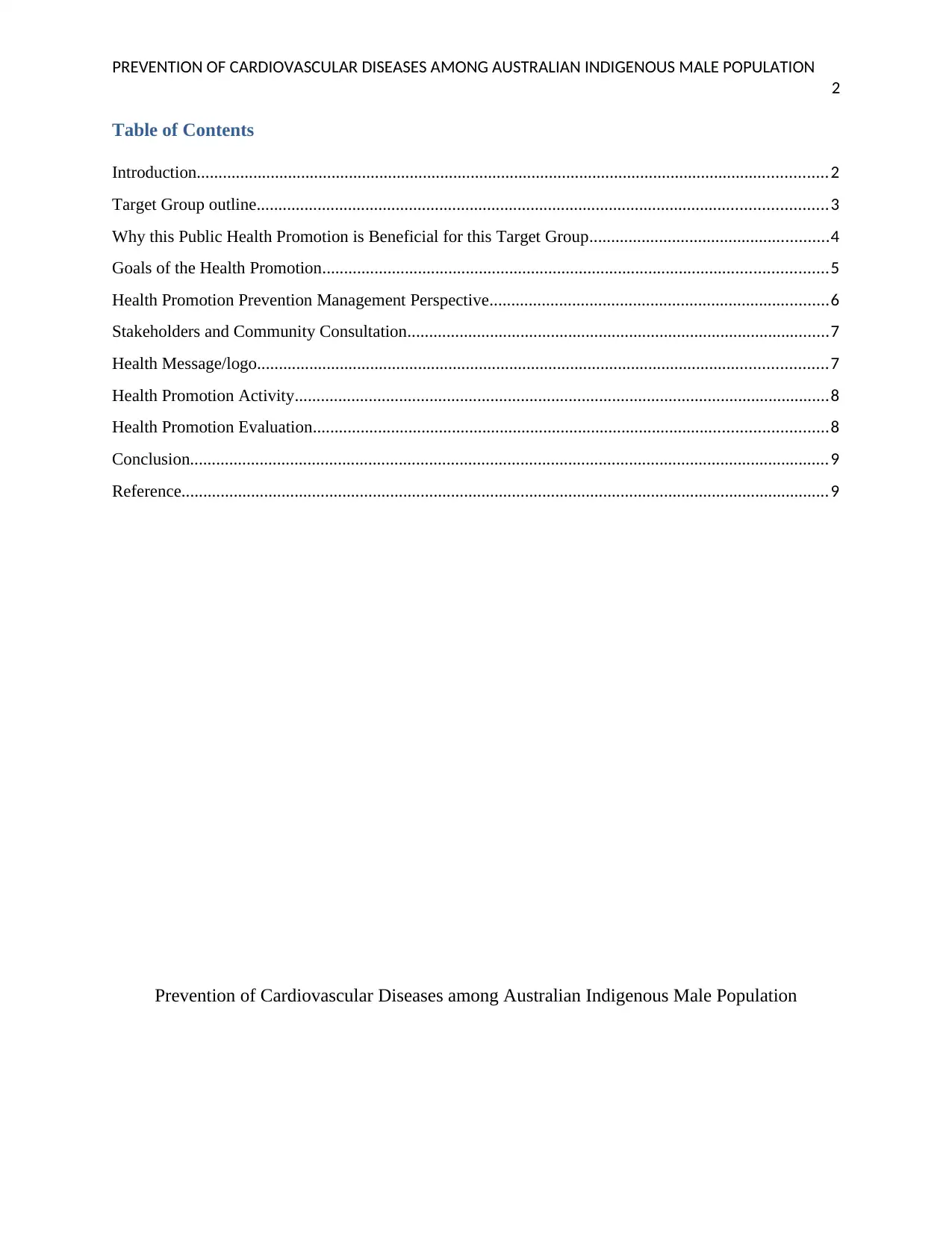
PREVENTION OF CARDIOVASCULAR DISEASES AMONG AUSTRALIAN INDIGENOUS MALE POPULATION
2
Table of Contents
Introduction.................................................................................................................................................2
Target Group outline...................................................................................................................................3
Why this Public Health Promotion is Beneficial for this Target Group.......................................................4
Goals of the Health Promotion....................................................................................................................5
Health Promotion Prevention Management Perspective..............................................................................6
Stakeholders and Community Consultation.................................................................................................7
Health Message/logo...................................................................................................................................7
Health Promotion Activity...........................................................................................................................8
Health Promotion Evaluation......................................................................................................................8
Conclusion...................................................................................................................................................9
Reference.....................................................................................................................................................9
Prevention of Cardiovascular Diseases among Australian Indigenous Male Population
2
Table of Contents
Introduction.................................................................................................................................................2
Target Group outline...................................................................................................................................3
Why this Public Health Promotion is Beneficial for this Target Group.......................................................4
Goals of the Health Promotion....................................................................................................................5
Health Promotion Prevention Management Perspective..............................................................................6
Stakeholders and Community Consultation.................................................................................................7
Health Message/logo...................................................................................................................................7
Health Promotion Activity...........................................................................................................................8
Health Promotion Evaluation......................................................................................................................8
Conclusion...................................................................................................................................................9
Reference.....................................................................................................................................................9
Prevention of Cardiovascular Diseases among Australian Indigenous Male Population
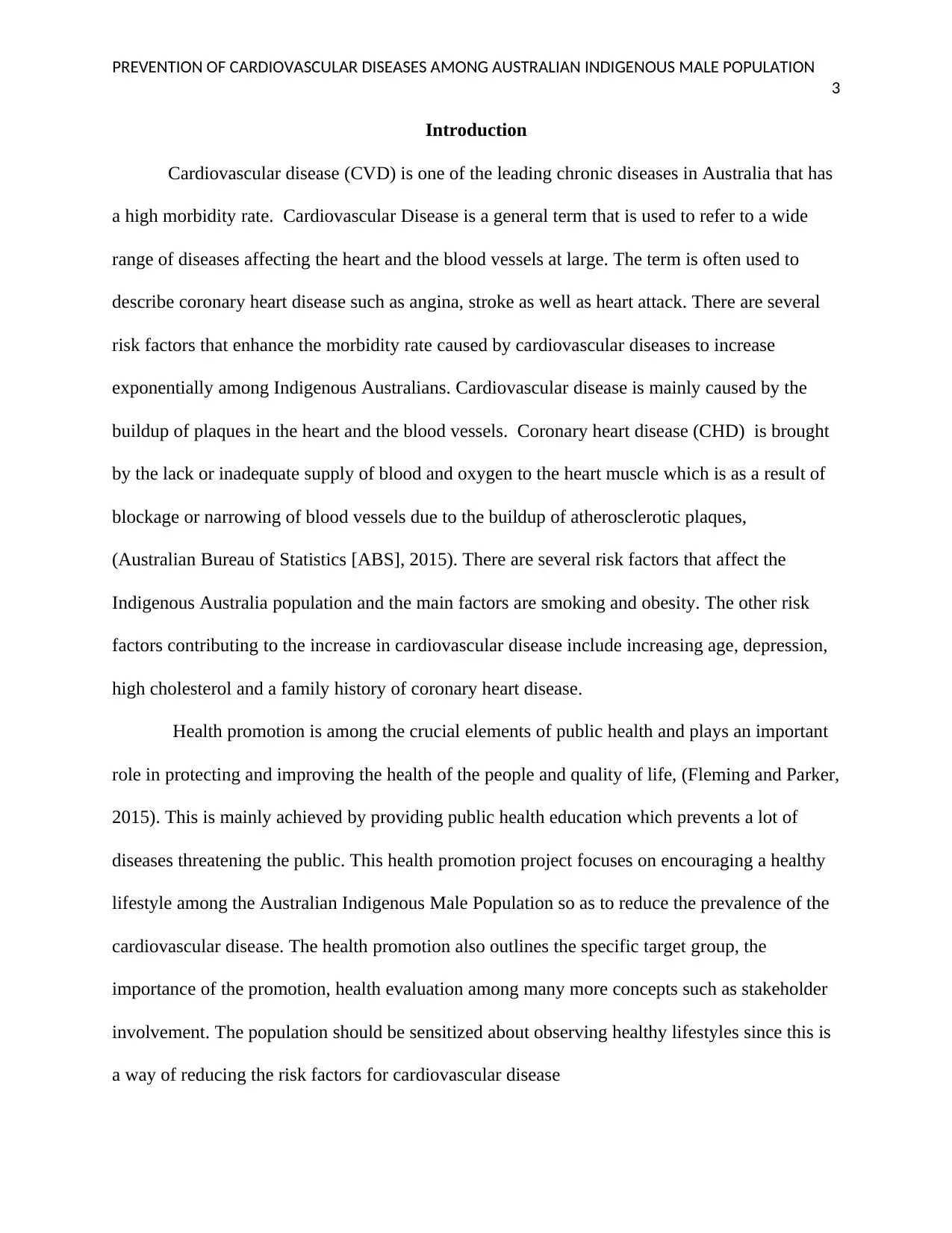
PREVENTION OF CARDIOVASCULAR DISEASES AMONG AUSTRALIAN INDIGENOUS MALE POPULATION
3
Introduction
Cardiovascular disease (CVD) is one of the leading chronic diseases in Australia that has
a high morbidity rate. Cardiovascular Disease is a general term that is used to refer to a wide
range of diseases affecting the heart and the blood vessels at large. The term is often used to
describe coronary heart disease such as angina, stroke as well as heart attack. There are several
risk factors that enhance the morbidity rate caused by cardiovascular diseases to increase
exponentially among Indigenous Australians. Cardiovascular disease is mainly caused by the
buildup of plaques in the heart and the blood vessels. Coronary heart disease (CHD) is brought
by the lack or inadequate supply of blood and oxygen to the heart muscle which is as a result of
blockage or narrowing of blood vessels due to the buildup of atherosclerotic plaques,
(Australian Bureau of Statistics [ABS], 2015). There are several risk factors that affect the
Indigenous Australia population and the main factors are smoking and obesity. The other risk
factors contributing to the increase in cardiovascular disease include increasing age, depression,
high cholesterol and a family history of coronary heart disease.
Health promotion is among the crucial elements of public health and plays an important
role in protecting and improving the health of the people and quality of life, (Fleming and Parker,
2015). This is mainly achieved by providing public health education which prevents a lot of
diseases threatening the public. This health promotion project focuses on encouraging a healthy
lifestyle among the Australian Indigenous Male Population so as to reduce the prevalence of the
cardiovascular disease. The health promotion also outlines the specific target group, the
importance of the promotion, health evaluation among many more concepts such as stakeholder
involvement. The population should be sensitized about observing healthy lifestyles since this is
a way of reducing the risk factors for cardiovascular disease
3
Introduction
Cardiovascular disease (CVD) is one of the leading chronic diseases in Australia that has
a high morbidity rate. Cardiovascular Disease is a general term that is used to refer to a wide
range of diseases affecting the heart and the blood vessels at large. The term is often used to
describe coronary heart disease such as angina, stroke as well as heart attack. There are several
risk factors that enhance the morbidity rate caused by cardiovascular diseases to increase
exponentially among Indigenous Australians. Cardiovascular disease is mainly caused by the
buildup of plaques in the heart and the blood vessels. Coronary heart disease (CHD) is brought
by the lack or inadequate supply of blood and oxygen to the heart muscle which is as a result of
blockage or narrowing of blood vessels due to the buildup of atherosclerotic plaques,
(Australian Bureau of Statistics [ABS], 2015). There are several risk factors that affect the
Indigenous Australia population and the main factors are smoking and obesity. The other risk
factors contributing to the increase in cardiovascular disease include increasing age, depression,
high cholesterol and a family history of coronary heart disease.
Health promotion is among the crucial elements of public health and plays an important
role in protecting and improving the health of the people and quality of life, (Fleming and Parker,
2015). This is mainly achieved by providing public health education which prevents a lot of
diseases threatening the public. This health promotion project focuses on encouraging a healthy
lifestyle among the Australian Indigenous Male Population so as to reduce the prevalence of the
cardiovascular disease. The health promotion also outlines the specific target group, the
importance of the promotion, health evaluation among many more concepts such as stakeholder
involvement. The population should be sensitized about observing healthy lifestyles since this is
a way of reducing the risk factors for cardiovascular disease
⊘ This is a preview!⊘
Do you want full access?
Subscribe today to unlock all pages.

Trusted by 1+ million students worldwide
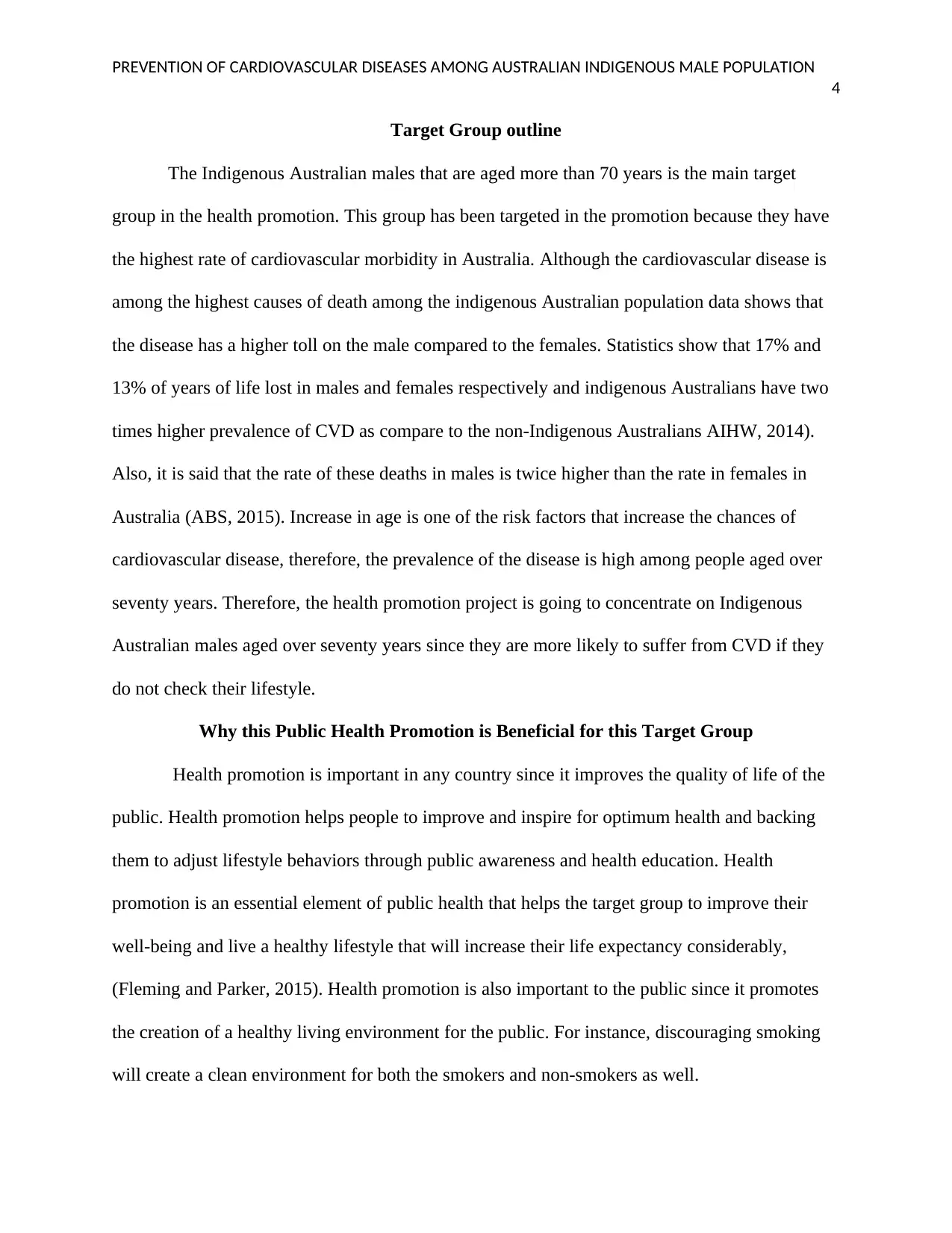
PREVENTION OF CARDIOVASCULAR DISEASES AMONG AUSTRALIAN INDIGENOUS MALE POPULATION
4
Target Group outline
The Indigenous Australian males that are aged more than 70 years is the main target
group in the health promotion. This group has been targeted in the promotion because they have
the highest rate of cardiovascular morbidity in Australia. Although the cardiovascular disease is
among the highest causes of death among the indigenous Australian population data shows that
the disease has a higher toll on the male compared to the females. Statistics show that 17% and
13% of years of life lost in males and females respectively and indigenous Australians have two
times higher prevalence of CVD as compare to the non-Indigenous Australians AIHW, 2014).
Also, it is said that the rate of these deaths in males is twice higher than the rate in females in
Australia (ABS, 2015). Increase in age is one of the risk factors that increase the chances of
cardiovascular disease, therefore, the prevalence of the disease is high among people aged over
seventy years. Therefore, the health promotion project is going to concentrate on Indigenous
Australian males aged over seventy years since they are more likely to suffer from CVD if they
do not check their lifestyle.
Why this Public Health Promotion is Beneficial for this Target Group
Health promotion is important in any country since it improves the quality of life of the
public. Health promotion helps people to improve and inspire for optimum health and backing
them to adjust lifestyle behaviors through public awareness and health education. Health
promotion is an essential element of public health that helps the target group to improve their
well-being and live a healthy lifestyle that will increase their life expectancy considerably,
(Fleming and Parker, 2015). Health promotion is also important to the public since it promotes
the creation of a healthy living environment for the public. For instance, discouraging smoking
will create a clean environment for both the smokers and non-smokers as well.
4
Target Group outline
The Indigenous Australian males that are aged more than 70 years is the main target
group in the health promotion. This group has been targeted in the promotion because they have
the highest rate of cardiovascular morbidity in Australia. Although the cardiovascular disease is
among the highest causes of death among the indigenous Australian population data shows that
the disease has a higher toll on the male compared to the females. Statistics show that 17% and
13% of years of life lost in males and females respectively and indigenous Australians have two
times higher prevalence of CVD as compare to the non-Indigenous Australians AIHW, 2014).
Also, it is said that the rate of these deaths in males is twice higher than the rate in females in
Australia (ABS, 2015). Increase in age is one of the risk factors that increase the chances of
cardiovascular disease, therefore, the prevalence of the disease is high among people aged over
seventy years. Therefore, the health promotion project is going to concentrate on Indigenous
Australian males aged over seventy years since they are more likely to suffer from CVD if they
do not check their lifestyle.
Why this Public Health Promotion is Beneficial for this Target Group
Health promotion is important in any country since it improves the quality of life of the
public. Health promotion helps people to improve and inspire for optimum health and backing
them to adjust lifestyle behaviors through public awareness and health education. Health
promotion is an essential element of public health that helps the target group to improve their
well-being and live a healthy lifestyle that will increase their life expectancy considerably,
(Fleming and Parker, 2015). Health promotion is also important to the public since it promotes
the creation of a healthy living environment for the public. For instance, discouraging smoking
will create a clean environment for both the smokers and non-smokers as well.
Paraphrase This Document
Need a fresh take? Get an instant paraphrase of this document with our AI Paraphraser
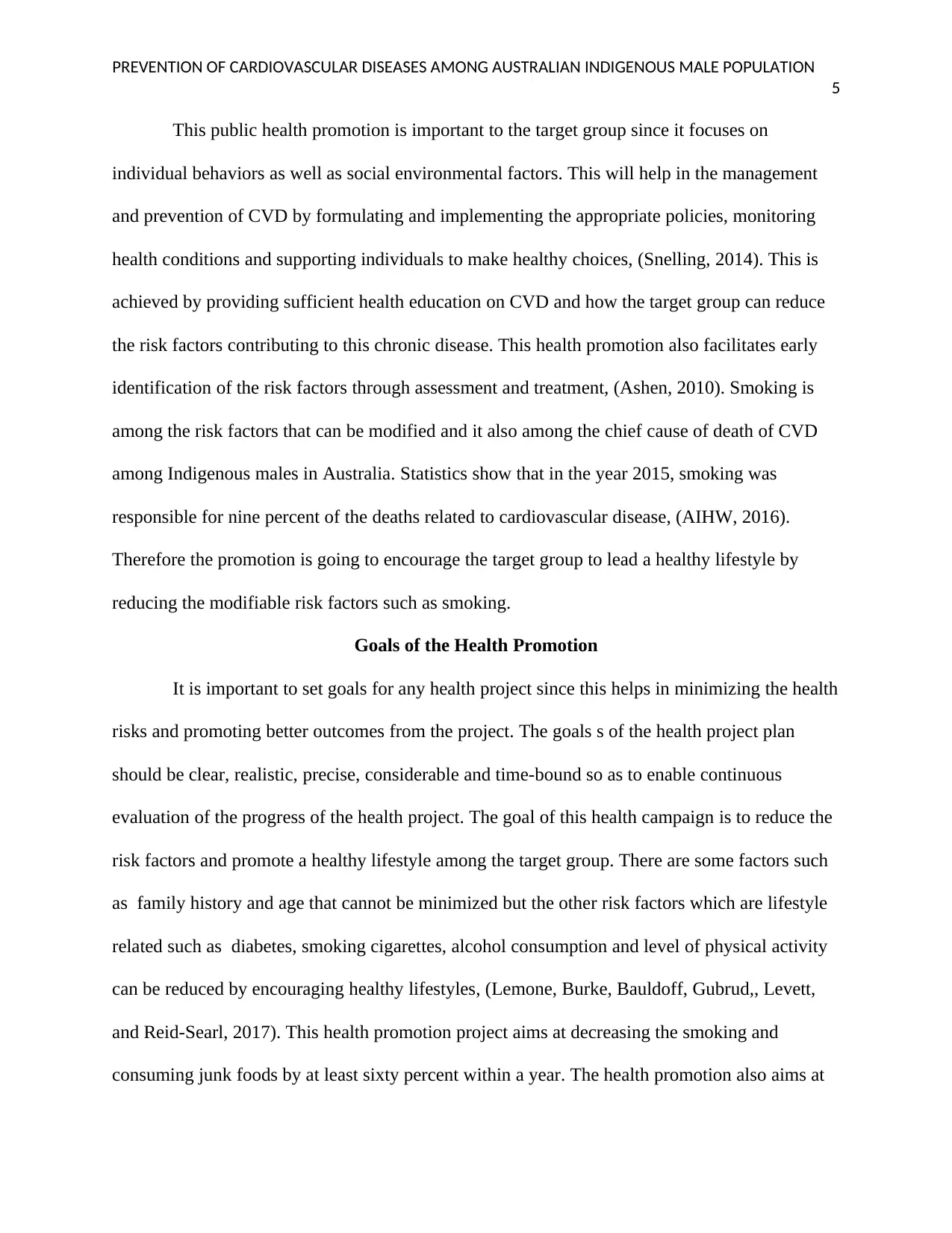
PREVENTION OF CARDIOVASCULAR DISEASES AMONG AUSTRALIAN INDIGENOUS MALE POPULATION
5
This public health promotion is important to the target group since it focuses on
individual behaviors as well as social environmental factors. This will help in the management
and prevention of CVD by formulating and implementing the appropriate policies, monitoring
health conditions and supporting individuals to make healthy choices, (Snelling, 2014). This is
achieved by providing sufficient health education on CVD and how the target group can reduce
the risk factors contributing to this chronic disease. This health promotion also facilitates early
identification of the risk factors through assessment and treatment, (Ashen, 2010). Smoking is
among the risk factors that can be modified and it also among the chief cause of death of CVD
among Indigenous males in Australia. Statistics show that in the year 2015, smoking was
responsible for nine percent of the deaths related to cardiovascular disease, (AIHW, 2016).
Therefore the promotion is going to encourage the target group to lead a healthy lifestyle by
reducing the modifiable risk factors such as smoking.
Goals of the Health Promotion
It is important to set goals for any health project since this helps in minimizing the health
risks and promoting better outcomes from the project. The goals s of the health project plan
should be clear, realistic, precise, considerable and time-bound so as to enable continuous
evaluation of the progress of the health project. The goal of this health campaign is to reduce the
risk factors and promote a healthy lifestyle among the target group. There are some factors such
as family history and age that cannot be minimized but the other risk factors which are lifestyle
related such as diabetes, smoking cigarettes, alcohol consumption and level of physical activity
can be reduced by encouraging healthy lifestyles, (Lemone, Burke, Bauldoff, Gubrud,, Levett,
and Reid-Searl, 2017). This health promotion project aims at decreasing the smoking and
consuming junk foods by at least sixty percent within a year. The health promotion also aims at
5
This public health promotion is important to the target group since it focuses on
individual behaviors as well as social environmental factors. This will help in the management
and prevention of CVD by formulating and implementing the appropriate policies, monitoring
health conditions and supporting individuals to make healthy choices, (Snelling, 2014). This is
achieved by providing sufficient health education on CVD and how the target group can reduce
the risk factors contributing to this chronic disease. This health promotion also facilitates early
identification of the risk factors through assessment and treatment, (Ashen, 2010). Smoking is
among the risk factors that can be modified and it also among the chief cause of death of CVD
among Indigenous males in Australia. Statistics show that in the year 2015, smoking was
responsible for nine percent of the deaths related to cardiovascular disease, (AIHW, 2016).
Therefore the promotion is going to encourage the target group to lead a healthy lifestyle by
reducing the modifiable risk factors such as smoking.
Goals of the Health Promotion
It is important to set goals for any health project since this helps in minimizing the health
risks and promoting better outcomes from the project. The goals s of the health project plan
should be clear, realistic, precise, considerable and time-bound so as to enable continuous
evaluation of the progress of the health project. The goal of this health campaign is to reduce the
risk factors and promote a healthy lifestyle among the target group. There are some factors such
as family history and age that cannot be minimized but the other risk factors which are lifestyle
related such as diabetes, smoking cigarettes, alcohol consumption and level of physical activity
can be reduced by encouraging healthy lifestyles, (Lemone, Burke, Bauldoff, Gubrud,, Levett,
and Reid-Searl, 2017). This health promotion project aims at decreasing the smoking and
consuming junk foods by at least sixty percent within a year. The health promotion also aims at
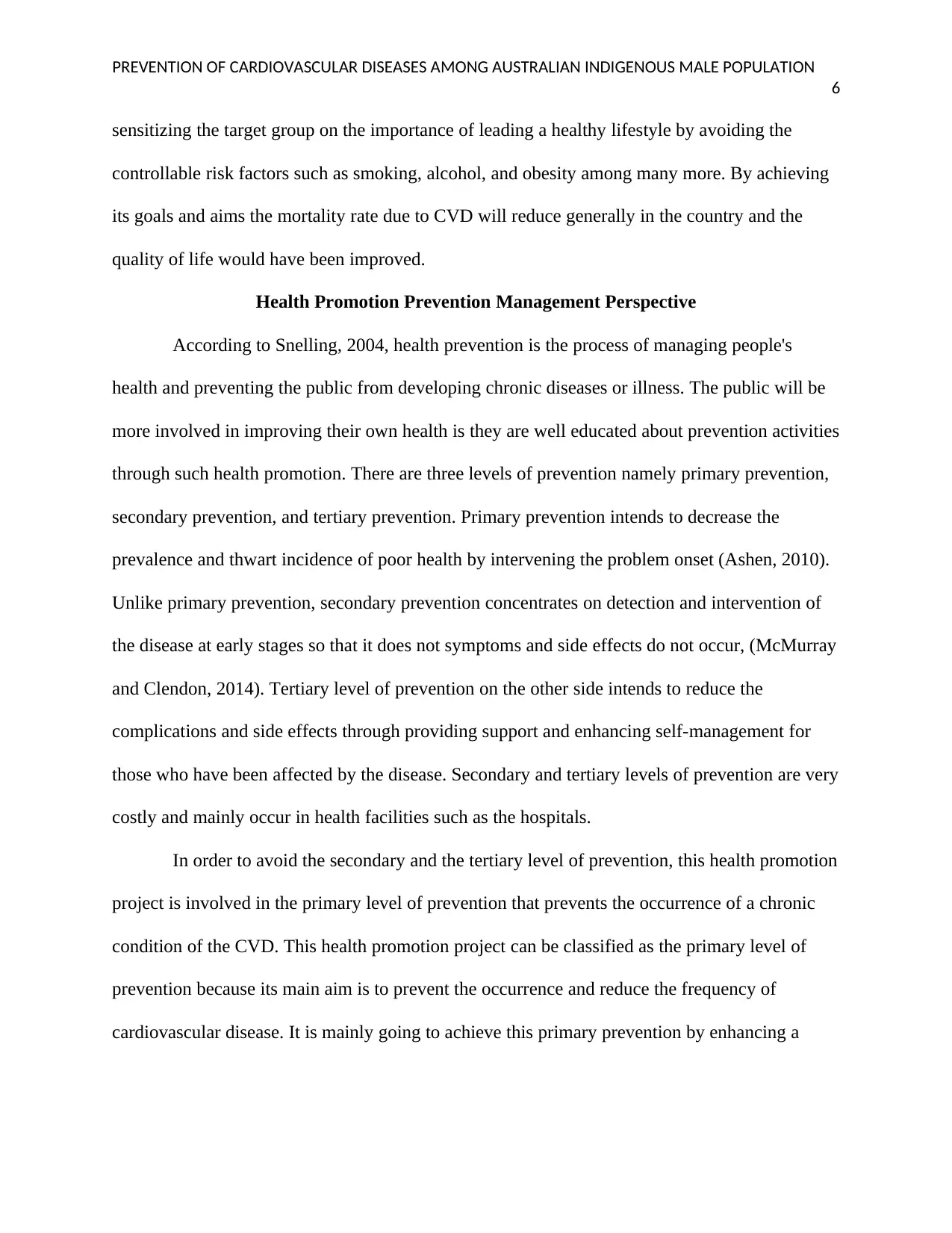
PREVENTION OF CARDIOVASCULAR DISEASES AMONG AUSTRALIAN INDIGENOUS MALE POPULATION
6
sensitizing the target group on the importance of leading a healthy lifestyle by avoiding the
controllable risk factors such as smoking, alcohol, and obesity among many more. By achieving
its goals and aims the mortality rate due to CVD will reduce generally in the country and the
quality of life would have been improved.
Health Promotion Prevention Management Perspective
According to Snelling, 2004, health prevention is the process of managing people's
health and preventing the public from developing chronic diseases or illness. The public will be
more involved in improving their own health is they are well educated about prevention activities
through such health promotion. There are three levels of prevention namely primary prevention,
secondary prevention, and tertiary prevention. Primary prevention intends to decrease the
prevalence and thwart incidence of poor health by intervening the problem onset (Ashen, 2010).
Unlike primary prevention, secondary prevention concentrates on detection and intervention of
the disease at early stages so that it does not symptoms and side effects do not occur, (McMurray
and Clendon, 2014). Tertiary level of prevention on the other side intends to reduce the
complications and side effects through providing support and enhancing self-management for
those who have been affected by the disease. Secondary and tertiary levels of prevention are very
costly and mainly occur in health facilities such as the hospitals.
In order to avoid the secondary and the tertiary level of prevention, this health promotion
project is involved in the primary level of prevention that prevents the occurrence of a chronic
condition of the CVD. This health promotion project can be classified as the primary level of
prevention because its main aim is to prevent the occurrence and reduce the frequency of
cardiovascular disease. It is mainly going to achieve this primary prevention by enhancing a
6
sensitizing the target group on the importance of leading a healthy lifestyle by avoiding the
controllable risk factors such as smoking, alcohol, and obesity among many more. By achieving
its goals and aims the mortality rate due to CVD will reduce generally in the country and the
quality of life would have been improved.
Health Promotion Prevention Management Perspective
According to Snelling, 2004, health prevention is the process of managing people's
health and preventing the public from developing chronic diseases or illness. The public will be
more involved in improving their own health is they are well educated about prevention activities
through such health promotion. There are three levels of prevention namely primary prevention,
secondary prevention, and tertiary prevention. Primary prevention intends to decrease the
prevalence and thwart incidence of poor health by intervening the problem onset (Ashen, 2010).
Unlike primary prevention, secondary prevention concentrates on detection and intervention of
the disease at early stages so that it does not symptoms and side effects do not occur, (McMurray
and Clendon, 2014). Tertiary level of prevention on the other side intends to reduce the
complications and side effects through providing support and enhancing self-management for
those who have been affected by the disease. Secondary and tertiary levels of prevention are very
costly and mainly occur in health facilities such as the hospitals.
In order to avoid the secondary and the tertiary level of prevention, this health promotion
project is involved in the primary level of prevention that prevents the occurrence of a chronic
condition of the CVD. This health promotion project can be classified as the primary level of
prevention because its main aim is to prevent the occurrence and reduce the frequency of
cardiovascular disease. It is mainly going to achieve this primary prevention by enhancing a
⊘ This is a preview!⊘
Do you want full access?
Subscribe today to unlock all pages.

Trusted by 1+ million students worldwide
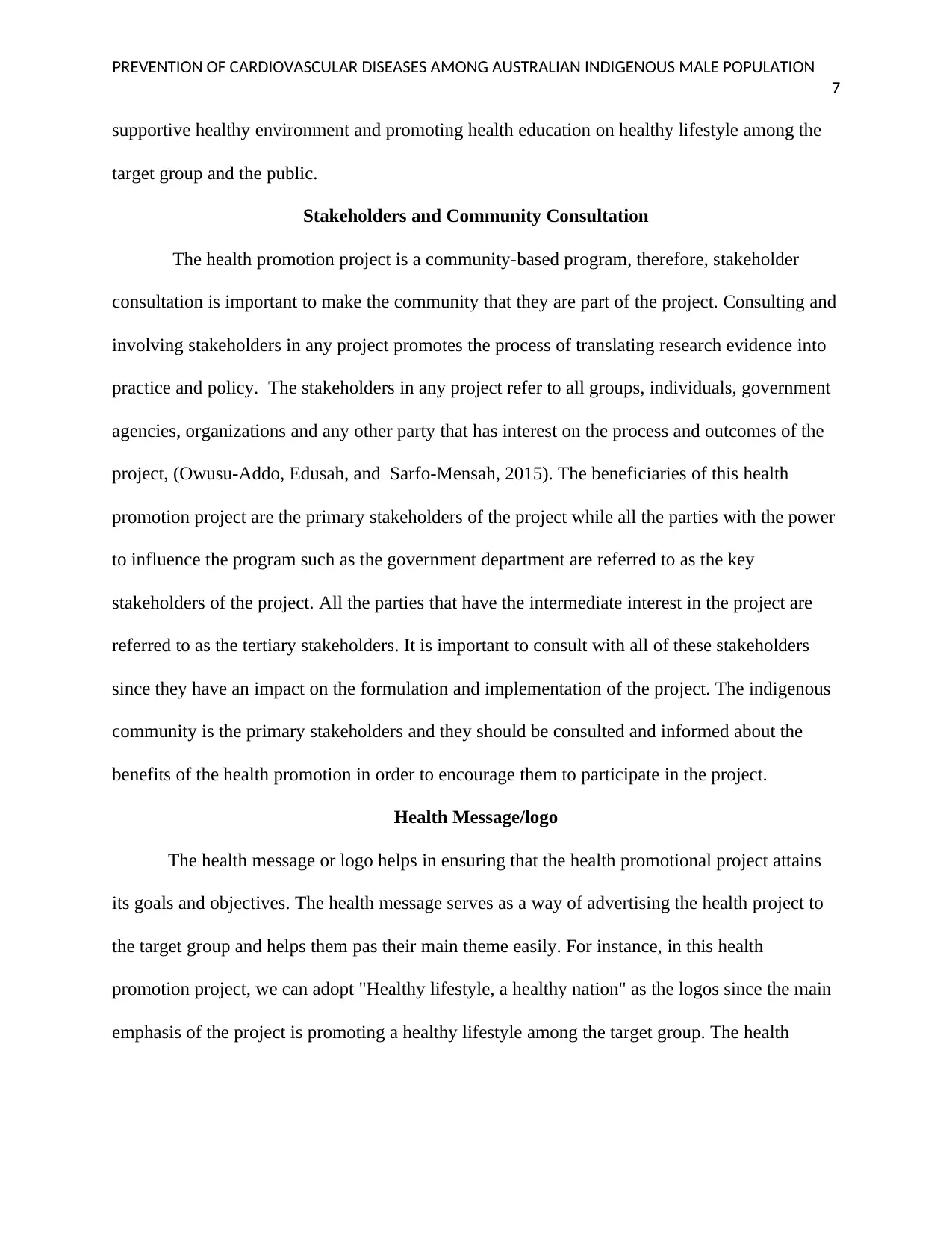
PREVENTION OF CARDIOVASCULAR DISEASES AMONG AUSTRALIAN INDIGENOUS MALE POPULATION
7
supportive healthy environment and promoting health education on healthy lifestyle among the
target group and the public.
Stakeholders and Community Consultation
The health promotion project is a community-based program, therefore, stakeholder
consultation is important to make the community that they are part of the project. Consulting and
involving stakeholders in any project promotes the process of translating research evidence into
practice and policy. The stakeholders in any project refer to all groups, individuals, government
agencies, organizations and any other party that has interest on the process and outcomes of the
project, (Owusu-Addo, Edusah, and Sarfo-Mensah, 2015). The beneficiaries of this health
promotion project are the primary stakeholders of the project while all the parties with the power
to influence the program such as the government department are referred to as the key
stakeholders of the project. All the parties that have the intermediate interest in the project are
referred to as the tertiary stakeholders. It is important to consult with all of these stakeholders
since they have an impact on the formulation and implementation of the project. The indigenous
community is the primary stakeholders and they should be consulted and informed about the
benefits of the health promotion in order to encourage them to participate in the project.
Health Message/logo
The health message or logo helps in ensuring that the health promotional project attains
its goals and objectives. The health message serves as a way of advertising the health project to
the target group and helps them pas their main theme easily. For instance, in this health
promotion project, we can adopt "Healthy lifestyle, a healthy nation" as the logos since the main
emphasis of the project is promoting a healthy lifestyle among the target group. The health
7
supportive healthy environment and promoting health education on healthy lifestyle among the
target group and the public.
Stakeholders and Community Consultation
The health promotion project is a community-based program, therefore, stakeholder
consultation is important to make the community that they are part of the project. Consulting and
involving stakeholders in any project promotes the process of translating research evidence into
practice and policy. The stakeholders in any project refer to all groups, individuals, government
agencies, organizations and any other party that has interest on the process and outcomes of the
project, (Owusu-Addo, Edusah, and Sarfo-Mensah, 2015). The beneficiaries of this health
promotion project are the primary stakeholders of the project while all the parties with the power
to influence the program such as the government department are referred to as the key
stakeholders of the project. All the parties that have the intermediate interest in the project are
referred to as the tertiary stakeholders. It is important to consult with all of these stakeholders
since they have an impact on the formulation and implementation of the project. The indigenous
community is the primary stakeholders and they should be consulted and informed about the
benefits of the health promotion in order to encourage them to participate in the project.
Health Message/logo
The health message or logo helps in ensuring that the health promotional project attains
its goals and objectives. The health message serves as a way of advertising the health project to
the target group and helps them pas their main theme easily. For instance, in this health
promotion project, we can adopt "Healthy lifestyle, a healthy nation" as the logos since the main
emphasis of the project is promoting a healthy lifestyle among the target group. The health
Paraphrase This Document
Need a fresh take? Get an instant paraphrase of this document with our AI Paraphraser
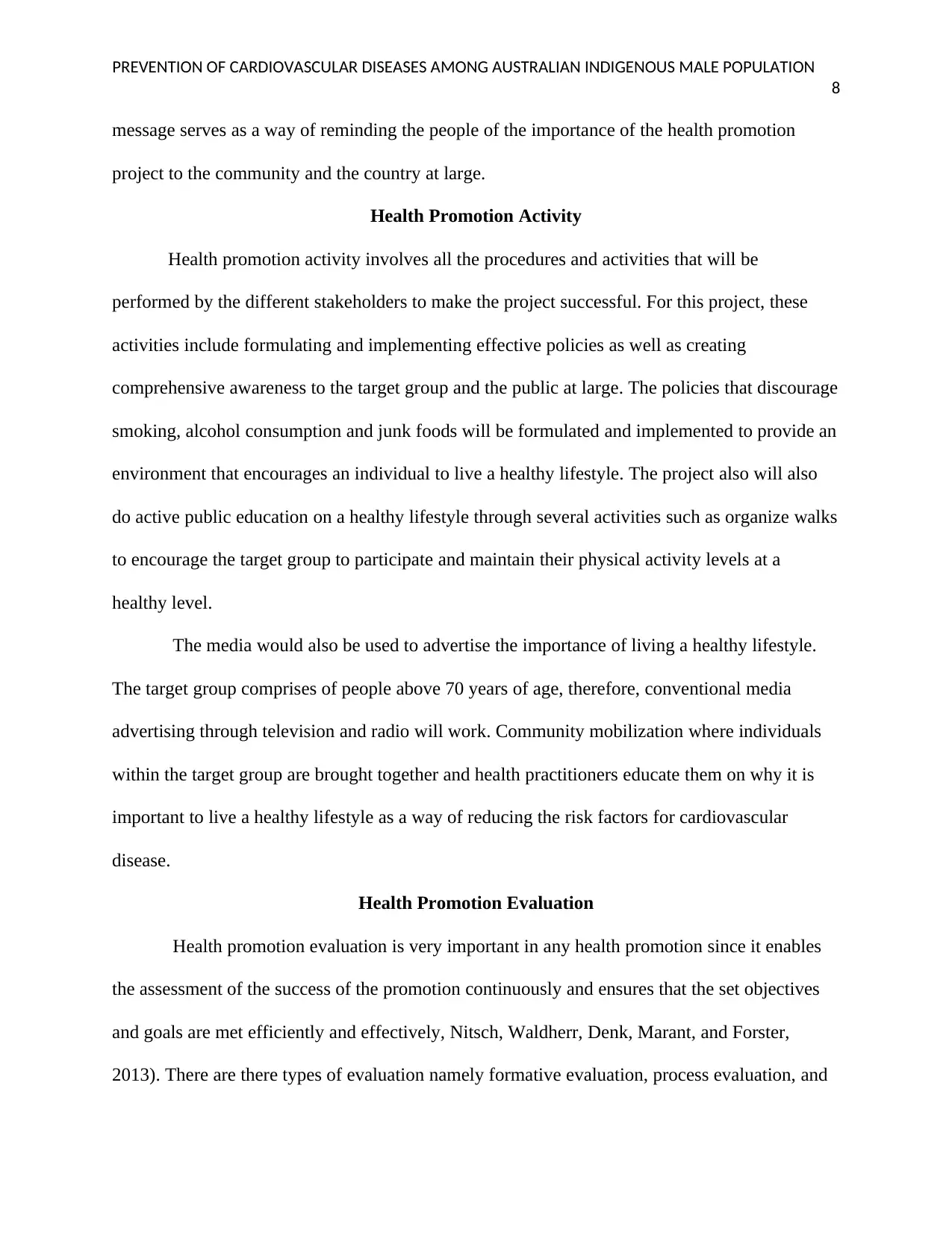
PREVENTION OF CARDIOVASCULAR DISEASES AMONG AUSTRALIAN INDIGENOUS MALE POPULATION
8
message serves as a way of reminding the people of the importance of the health promotion
project to the community and the country at large.
Health Promotion Activity
Health promotion activity involves all the procedures and activities that will be
performed by the different stakeholders to make the project successful. For this project, these
activities include formulating and implementing effective policies as well as creating
comprehensive awareness to the target group and the public at large. The policies that discourage
smoking, alcohol consumption and junk foods will be formulated and implemented to provide an
environment that encourages an individual to live a healthy lifestyle. The project also will also
do active public education on a healthy lifestyle through several activities such as organize walks
to encourage the target group to participate and maintain their physical activity levels at a
healthy level.
The media would also be used to advertise the importance of living a healthy lifestyle.
The target group comprises of people above 70 years of age, therefore, conventional media
advertising through television and radio will work. Community mobilization where individuals
within the target group are brought together and health practitioners educate them on why it is
important to live a healthy lifestyle as a way of reducing the risk factors for cardiovascular
disease.
Health Promotion Evaluation
Health promotion evaluation is very important in any health promotion since it enables
the assessment of the success of the promotion continuously and ensures that the set objectives
and goals are met efficiently and effectively, Nitsch, Waldherr, Denk, Marant, and Forster,
2013). There are there types of evaluation namely formative evaluation, process evaluation, and
8
message serves as a way of reminding the people of the importance of the health promotion
project to the community and the country at large.
Health Promotion Activity
Health promotion activity involves all the procedures and activities that will be
performed by the different stakeholders to make the project successful. For this project, these
activities include formulating and implementing effective policies as well as creating
comprehensive awareness to the target group and the public at large. The policies that discourage
smoking, alcohol consumption and junk foods will be formulated and implemented to provide an
environment that encourages an individual to live a healthy lifestyle. The project also will also
do active public education on a healthy lifestyle through several activities such as organize walks
to encourage the target group to participate and maintain their physical activity levels at a
healthy level.
The media would also be used to advertise the importance of living a healthy lifestyle.
The target group comprises of people above 70 years of age, therefore, conventional media
advertising through television and radio will work. Community mobilization where individuals
within the target group are brought together and health practitioners educate them on why it is
important to live a healthy lifestyle as a way of reducing the risk factors for cardiovascular
disease.
Health Promotion Evaluation
Health promotion evaluation is very important in any health promotion since it enables
the assessment of the success of the promotion continuously and ensures that the set objectives
and goals are met efficiently and effectively, Nitsch, Waldherr, Denk, Marant, and Forster,
2013). There are there types of evaluation namely formative evaluation, process evaluation, and
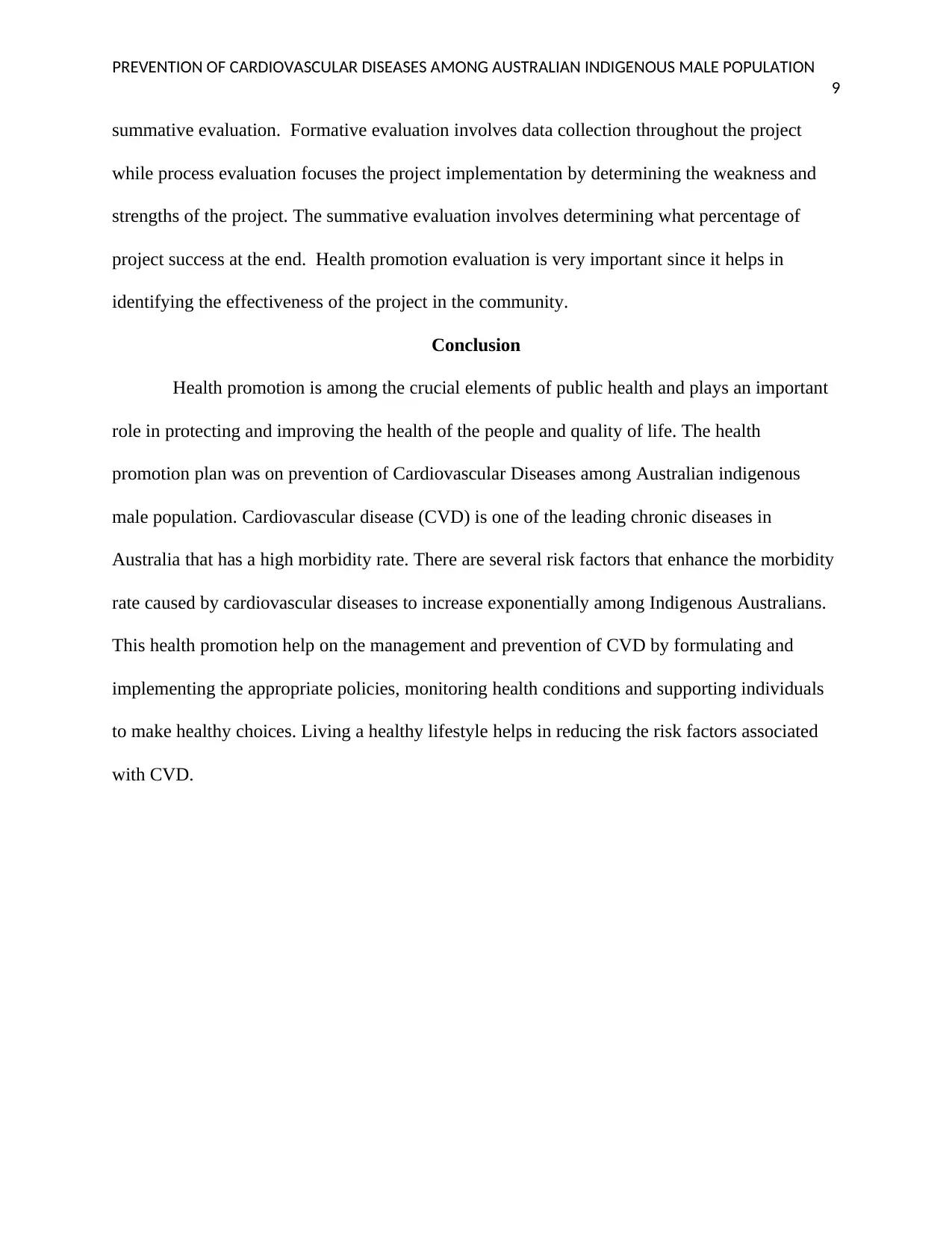
PREVENTION OF CARDIOVASCULAR DISEASES AMONG AUSTRALIAN INDIGENOUS MALE POPULATION
9
summative evaluation. Formative evaluation involves data collection throughout the project
while process evaluation focuses the project implementation by determining the weakness and
strengths of the project. The summative evaluation involves determining what percentage of
project success at the end. Health promotion evaluation is very important since it helps in
identifying the effectiveness of the project in the community.
Conclusion
Health promotion is among the crucial elements of public health and plays an important
role in protecting and improving the health of the people and quality of life. The health
promotion plan was on prevention of Cardiovascular Diseases among Australian indigenous
male population. Cardiovascular disease (CVD) is one of the leading chronic diseases in
Australia that has a high morbidity rate. There are several risk factors that enhance the morbidity
rate caused by cardiovascular diseases to increase exponentially among Indigenous Australians.
This health promotion help on the management and prevention of CVD by formulating and
implementing the appropriate policies, monitoring health conditions and supporting individuals
to make healthy choices. Living a healthy lifestyle helps in reducing the risk factors associated
with CVD.
9
summative evaluation. Formative evaluation involves data collection throughout the project
while process evaluation focuses the project implementation by determining the weakness and
strengths of the project. The summative evaluation involves determining what percentage of
project success at the end. Health promotion evaluation is very important since it helps in
identifying the effectiveness of the project in the community.
Conclusion
Health promotion is among the crucial elements of public health and plays an important
role in protecting and improving the health of the people and quality of life. The health
promotion plan was on prevention of Cardiovascular Diseases among Australian indigenous
male population. Cardiovascular disease (CVD) is one of the leading chronic diseases in
Australia that has a high morbidity rate. There are several risk factors that enhance the morbidity
rate caused by cardiovascular diseases to increase exponentially among Indigenous Australians.
This health promotion help on the management and prevention of CVD by formulating and
implementing the appropriate policies, monitoring health conditions and supporting individuals
to make healthy choices. Living a healthy lifestyle helps in reducing the risk factors associated
with CVD.
⊘ This is a preview!⊘
Do you want full access?
Subscribe today to unlock all pages.

Trusted by 1+ million students worldwide
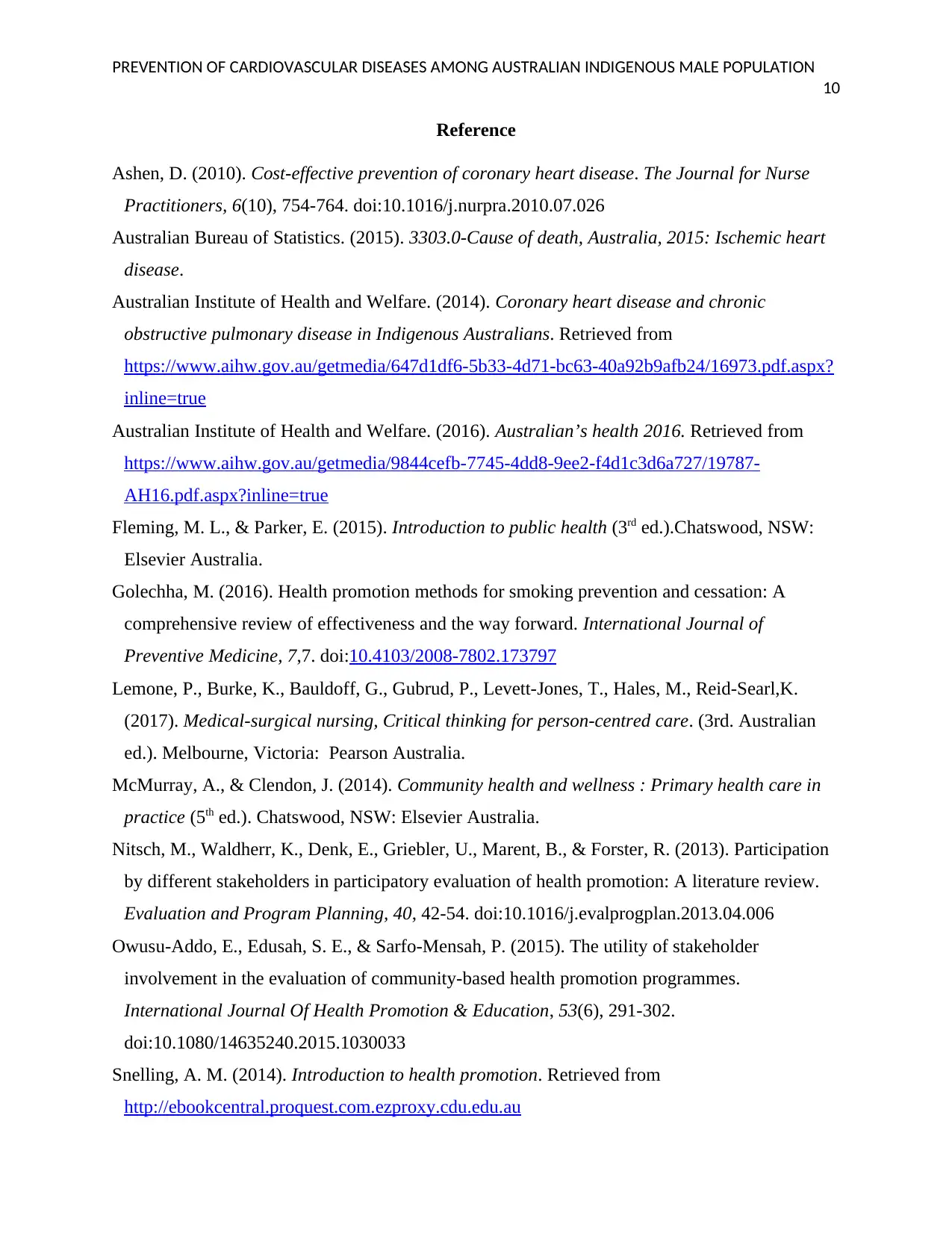
PREVENTION OF CARDIOVASCULAR DISEASES AMONG AUSTRALIAN INDIGENOUS MALE POPULATION
10
Reference
Ashen, D. (2010). Cost-effective prevention of coronary heart disease. The Journal for Nurse
Practitioners, 6(10), 754-764. doi:10.1016/j.nurpra.2010.07.026
Australian Bureau of Statistics. (2015). 3303.0-Cause of death, Australia, 2015: Ischemic heart
disease.
Australian Institute of Health and Welfare. (2014). Coronary heart disease and chronic
obstructive pulmonary disease in Indigenous Australians. Retrieved from
https://www.aihw.gov.au/getmedia/647d1df6-5b33-4d71-bc63-40a92b9afb24/16973.pdf.aspx?
inline=true
Australian Institute of Health and Welfare. (2016). Australian’s health 2016. Retrieved from
https://www.aihw.gov.au/getmedia/9844cefb-7745-4dd8-9ee2-f4d1c3d6a727/19787-
AH16.pdf.aspx?inline=true
Fleming, M. L., & Parker, E. (2015). Introduction to public health (3rd ed.).Chatswood, NSW:
Elsevier Australia.
Golechha, M. (2016). Health promotion methods for smoking prevention and cessation: A
comprehensive review of effectiveness and the way forward. International Journal of
Preventive Medicine, 7,7. doi:10.4103/2008-7802.173797
Lemone, P., Burke, K., Bauldoff, G., Gubrud, P., Levett-Jones, T., Hales, M., Reid-Searl,K.
(2017). Medical-surgical nursing, Critical thinking for person-centred care. (3rd. Australian
ed.). Melbourne, Victoria: Pearson Australia.
McMurray, A., & Clendon, J. (2014). Community health and wellness : Primary health care in
practice (5th ed.). Chatswood, NSW: Elsevier Australia.
Nitsch, M., Waldherr, K., Denk, E., Griebler, U., Marent, B., & Forster, R. (2013). Participation
by different stakeholders in participatory evaluation of health promotion: A literature review.
Evaluation and Program Planning, 40, 42-54. doi:10.1016/j.evalprogplan.2013.04.006
Owusu-Addo, E., Edusah, S. E., & Sarfo-Mensah, P. (2015). The utility of stakeholder
involvement in the evaluation of community-based health promotion programmes.
International Journal Of Health Promotion & Education, 53(6), 291-302.
doi:10.1080/14635240.2015.1030033
Snelling, A. M. (2014). Introduction to health promotion. Retrieved from
http://ebookcentral.proquest.com.ezproxy.cdu.edu.au
10
Reference
Ashen, D. (2010). Cost-effective prevention of coronary heart disease. The Journal for Nurse
Practitioners, 6(10), 754-764. doi:10.1016/j.nurpra.2010.07.026
Australian Bureau of Statistics. (2015). 3303.0-Cause of death, Australia, 2015: Ischemic heart
disease.
Australian Institute of Health and Welfare. (2014). Coronary heart disease and chronic
obstructive pulmonary disease in Indigenous Australians. Retrieved from
https://www.aihw.gov.au/getmedia/647d1df6-5b33-4d71-bc63-40a92b9afb24/16973.pdf.aspx?
inline=true
Australian Institute of Health and Welfare. (2016). Australian’s health 2016. Retrieved from
https://www.aihw.gov.au/getmedia/9844cefb-7745-4dd8-9ee2-f4d1c3d6a727/19787-
AH16.pdf.aspx?inline=true
Fleming, M. L., & Parker, E. (2015). Introduction to public health (3rd ed.).Chatswood, NSW:
Elsevier Australia.
Golechha, M. (2016). Health promotion methods for smoking prevention and cessation: A
comprehensive review of effectiveness and the way forward. International Journal of
Preventive Medicine, 7,7. doi:10.4103/2008-7802.173797
Lemone, P., Burke, K., Bauldoff, G., Gubrud, P., Levett-Jones, T., Hales, M., Reid-Searl,K.
(2017). Medical-surgical nursing, Critical thinking for person-centred care. (3rd. Australian
ed.). Melbourne, Victoria: Pearson Australia.
McMurray, A., & Clendon, J. (2014). Community health and wellness : Primary health care in
practice (5th ed.). Chatswood, NSW: Elsevier Australia.
Nitsch, M., Waldherr, K., Denk, E., Griebler, U., Marent, B., & Forster, R. (2013). Participation
by different stakeholders in participatory evaluation of health promotion: A literature review.
Evaluation and Program Planning, 40, 42-54. doi:10.1016/j.evalprogplan.2013.04.006
Owusu-Addo, E., Edusah, S. E., & Sarfo-Mensah, P. (2015). The utility of stakeholder
involvement in the evaluation of community-based health promotion programmes.
International Journal Of Health Promotion & Education, 53(6), 291-302.
doi:10.1080/14635240.2015.1030033
Snelling, A. M. (2014). Introduction to health promotion. Retrieved from
http://ebookcentral.proquest.com.ezproxy.cdu.edu.au
1 out of 10
Related Documents
Your All-in-One AI-Powered Toolkit for Academic Success.
+13062052269
info@desklib.com
Available 24*7 on WhatsApp / Email
![[object Object]](/_next/static/media/star-bottom.7253800d.svg)
Unlock your academic potential
Copyright © 2020–2025 A2Z Services. All Rights Reserved. Developed and managed by ZUCOL.




